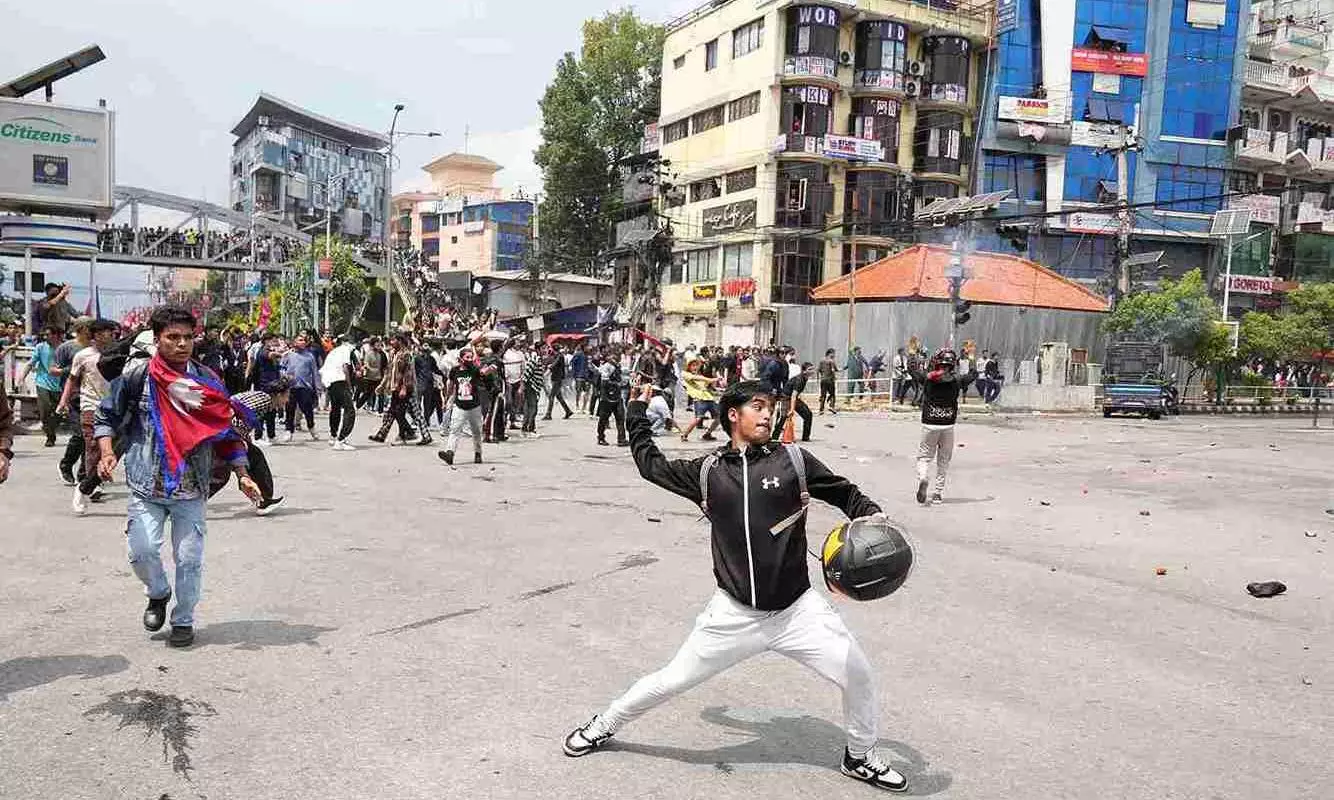
Nepal: Army deployed, curfew imposed as Gen Z protests turn deadly
Ban on 26 social media platforms, including Facebook and X, sparks student-led protests that turn violent, leaving at least 19 dead in Kathmandu

Chaos unfolded on Kathmandu’s streets on Monday (September 8) when the Nepal government called in the army to quell a rebellion led largely by students demanding that an arbitrary ban imposed on social media be revoked. Till last reports came in, at least 19 people were dead and scores injured as the ruckus on the streets continued.
Thousands of youths, including school students, under the banner of Gen Z (people born between 1996 and 2010), converged in front of the Parliament in the heart of Kathmandu and shouted anti-government slogans, demanding immediate revocation of the ban.
The demonstration turned violent when some protesters entered the Parliament complex, prompting the police to resort to baton charges, tear gas shells, and rubber bullets to disperse the crowd.
Also read: Nepal protests leave 14 dead: Why has Gen Z taken to the streets in revolt?
No official word on number of casualties
The BBC put the death toll at 19. However, there was no official word on the number of casualties.
Earlier, the Nepalese media put the death toll at 14. Citing hospital reports, the Himalayan Times newspaper reported that 14 people were killed in Kathmandu. The deceased include six at Trauma Centre, three at Civil Hospital, three at Everest Hospital, one at Kathmandu Medical College (KMC), and one at Tribhuvan University Teaching Hospital, the newspaper said.
News portal Khabarhub also reported the same, citing sources in the Ministry of Health and Population, while the Kantipur newspaper quoted doctors in Kathmandu hospitals.
A Nepal Police spokesperson said 42 people, including two security personnel, were injured and are currently undergoing treatment in the Civil Hospital of Kathmandu.
However, the Himalayan Times said the number of injured remains uncertain due to the large volume of cases. It added that hospitals, including the Civil Hospital and Trauma Centre, are struggling to accommodate patients and have begun referring them to other facilities.
Also read: India rebuts Nepal’s protest over Lipulekh pass; calls objections 'unjustified'
Curfew on, army on streets
Following the violence, the local administration imposed a curfew in several parts of the capital. The protest has spread to other cities also.
While the army has been deployed to control the situation, the Kathmandu District Administration issued a prohibitory order from 12.30 pm to 10 pm Monday in areas surrounding the Parliament building to curb the unrest.
“No movement of people, demonstration, meeting, gathering or sit-in will be allowed in the restricted zone,” Chief District Officer Chhabi Lal Rijal said in a notice.
The local administration later extended the restrictive order to various areas surrounding Rastrapati Bhawan, the Vice-President’s residence and the Prime Minister’s Office.
Also read: Nepal's PM Oli accuses former king of attempting to disrupt social harmony
Why ban social media?
The government on Thursday (September 4) banned 26 social media sites, including Facebook, WhatsApp, X, Instagram, and YouTube, for failing to register with the Ministry of Communication and Information Technology within the given deadline.
Although the government has clarified its stance that the social media sites were banned to bring them under regulation, the general perception among the masses is that this will lead to an attack on free speech, and it may lead to censorship.
Prime Minister KP Sharma Oli on Sunday said his government would “always oppose anomalies and arrogance, and would never accept any act that undermines the nation”.
The prime minister said the party is not against social media, “but what cannot be accepted is those doing business in Nepal, making money, and yet not complying with the law”. Referring to the criticism over the move, he called protesters and agitating voices “puppets who only oppose for the sake of opposing”.
Also read: Former Nepal King Gyanendra fined by Kathmandu civic body for vandalism
‘Nepo Kid’ campaign amid strong protests
Dozens of journalists demonstrated at Maitighar Mandala in the heart of Kathmandu on Sunday, protesting the government’s decision to ban 26 social media platforms.
Separately, the Computer Association of Nepal (CAN) in a statement said that shutting down important platforms like Facebook, X, and YouTube all at once can have a serious impact on education, business, communication, and the daily lives of ordinary citizens.
“This move of the government also poses the risk of Nepal falling behind the world digitally,” CAN president Sunaina Ghimire said, adding that sufficient discussions should be held with stakeholders to bring practical solutions.
Another group of youngsters, who launched a campaign called “Nepo Kid” on various social media platforms, are also joining the protest rally.
“Nepo Kid”, a social media trend, has become viral in recent days, with youngsters accusing the children of politicians and influential people of “enjoying privileges with money earned from corruption”.
(With agency inputs)

